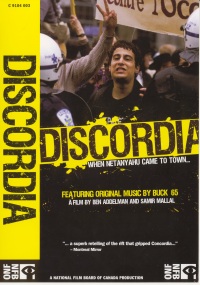| ________________
CM . . .
. Volume XI Number 3 . . . . October 1, 2004
excerpt:
Discordia is an extraordinary video which shows the key campus events, personalities and disparate points of view that surrounded the cancellation of former Israeli Prime Minister Benjamin Netanyahu's invitation to lecture at the George Williams Campus of Concordia University, Montreal. We watch as the on-campus appearance of Netanyahu, arranged by the Jewish student group Hillel, is canceled in the wake of a violent clash between anti-Netanyahu student protesters and riot police. The Concordia Student Union (CSU) was accused of anti-Semitism for opposing a visit by far-right wing Israeli politician Benjamin Netanyahu. Several students were arrested by police and charged for their involvement in the riot. The film provides us numerous first-hand interviews with three male student leaders: 1) Samer Elatrash (student leader of the pro-Palestinian contingent) who is the son of Palestinian refugees) 2) Aaron Mate (Concordia Student Union VP) who is the son of lefty-leaning Jews in solidarity with the Palestinians and 3) Noah Sarna (VP of Hillel, the Jewish community club on campus) an avowed supporter of Israel. At certain junctures, we hear and see interviews with their respective parents, giving us greater understanding of the roots of their deeply held feelings and campus activism. We hear and see Arab and Muslim students interacting with Jewish students on campus in various situations, including several scenes shot during the student riot itself. We are frequently shown Sabine Friesenger, Student President of the CSU, but do not hear too much from her overall. And to a lesser extent, we hear from students who want nothing to do with these issues and want only to get to class safely and get on with their studies. A short interchange between Aaron Mate and Noam Chomsky gives us an added historical perspective on anti-Semitism and anti-Muslim sentiment in Canada. The video does not have a narrator, but instead it makes good use of audio together with print captioning to explain what is happening before the camera. The hand-held camera and lapel microphones are used to give the viewer a sense of being in the middle of the action, watching emotional, fast-moving events transpire. The actual speeding up of some of the footage really suits this fast-forward, contemporary documentary film that records history in the making. The video is filmed in numerous campus and off-campus settings in order to show the complexity of the backgrounds and points of view of groups and individuals involved. On occasion, we can hear the questions being asked of those being interviewed by the filmmakers. The original music is undoubtedly a brilliant aspect of the video. In watching and understanding the issues portrayed in this video, the viewer is required to consider questions like the following: 1) Is pro-Palestinian sentiment the same as anti-Semitism? 2) Why are some Jewish students in support of the pro-Palestinian contingent, whereas other Jewish students revere Netanyahu? 3) Why did the announcement of Benjamin Netanyahu's lecture inflame the passions of the pro-Palestinian students? 4) Is speaking out against Israeli policy the same thing as anti-Semitism? 5) Where did freedom of speech and assembly figure into this story? 6) Does the film slant toward one side's position or the other? 7) Why and how did the events at Concordia capture the attention of the international media? 8) How did the university administration's involvement figure into Discordia? The online document "CBC Rough Cuts: Discordia" provides a most useful Timeline of Key Events stretching from September 2000 to April 2003 and would be a great help in discussions of the above questions. Grade 11 and 12 Canadian high school students, university students on the Canadian university campus in the new millennium, as well as organizers of guest speakers for campus forums should not miss a chance to view Discordia. Professors in such areas as law, media studies, social justice and peace, international relations, middle-east political science, film studies, music and journalism should arrange a screening and discussion of this riveting, original film for their classes. Administrators, faculty advisors and student union members should not miss this film. Highly Recommended. Cathy Vincent-Linderoos is a member of the Ontarians with Disability Act (ODA) Committee who retired early from elementary and secondary school teaching. She lives in London, ON.
To comment
on this title or this review, send mail to cm@umanitoba.ca.
Copyright © the Manitoba Library Association. Reproduction for personal
use is permitted only if this copyright notice is maintained. Any
other reproduction is prohibited without permission.
NEXT REVIEW |
TABLE OF CONTENTS FOR THIS ISSUE
- October 1, 2004.
AUTHORS |
TITLES |
MEDIA REVIEWS |
PROFILES |
BACK ISSUES |
SEARCH |
CMARCHIVE |
HOME |
